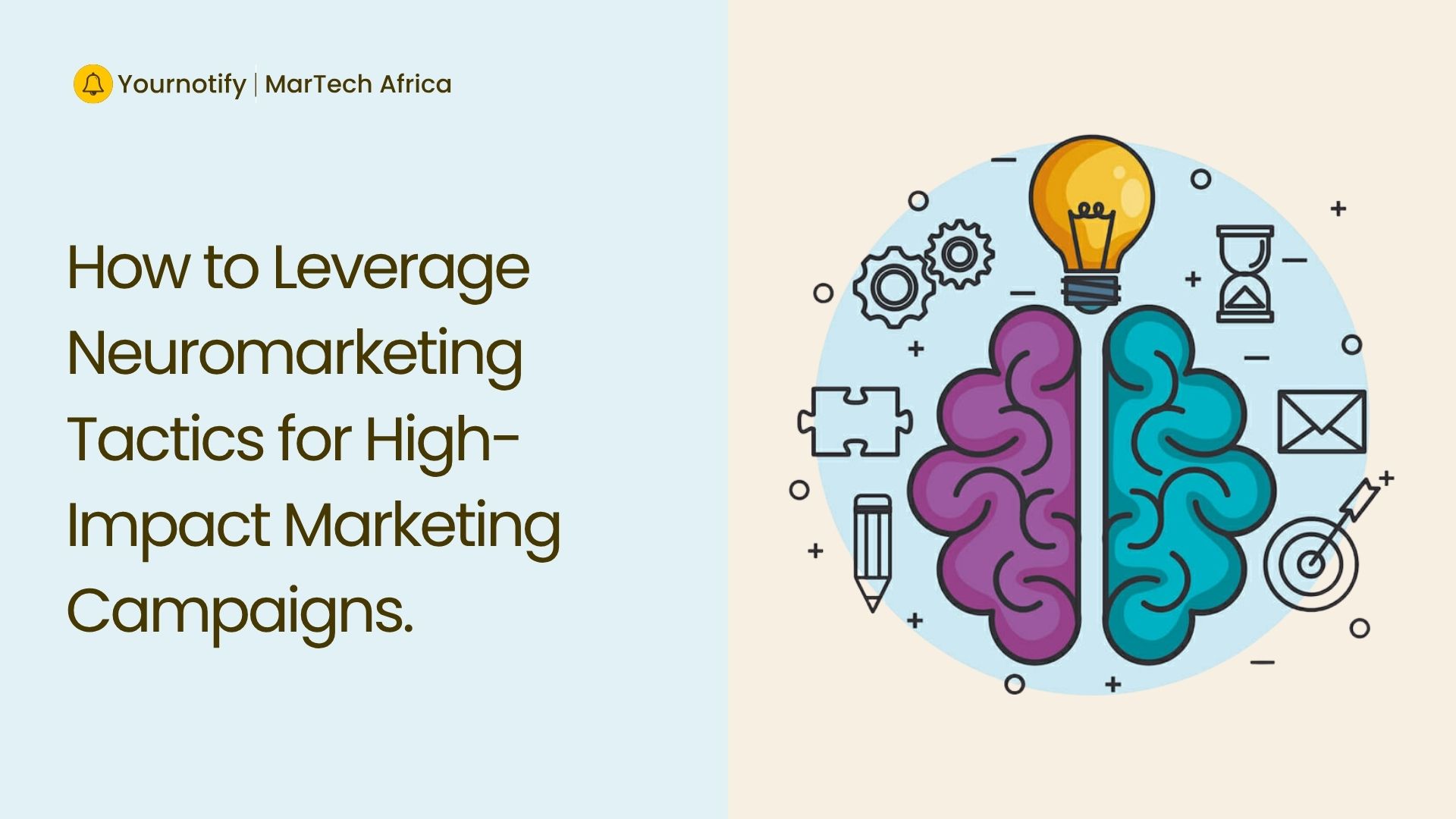Having neuromarketing tactics has become an integral part of marketing campaign strategies for businesses striving…

How Emerging Businesses Can Disrupt and Dominate Saturated Markets
Scroll through your phone today and you’ll see dozens of fintechs promising seamless transfers, skincare brands shouting “glow guaranteed,” and delivery apps all claiming to be faster. The problem is that every brand sounds the same. That’s where challenger brands step in.
Emerging businesses should somewhat question the rulebook. We see how startups like PiggyVest are reshaping how Nigerians save, or how Airbnb is rewriting hospitality.
In the coming years, markets will be even noisier, attention will be shorter, competition tighter, and consumers pickier. But that’s also the best time to be a challenger, when everyone’s playing it safe.
Ways Emerging Brands Can Disrupt and Dominate Saturated Markets
1. Think Like a Challenger
This might sound cliché, but yes, think like a challenger. Most small brands fail because they confuse imitation with inspiration. They look at what the biggest players are doing and assume that’s the only path forward, louder ads, flashier campaigns, similar slogans with new fonts. But that’s exactly why they stay invisible. Thinking like a challenger means refusing to follow the market’s rhythm and setting yours.
Challengers question assumptions others treat as law. For example, when Opay entered Nigeria’s obviously crowded fintech space, it didn’t try to compete with banks on image or luxury. It solved the real problem: broken trust in traditional banking systems. When transfers failed or apps crashed, Opay’s transactions still went through instantly.
Add to that their street-level presence, POS agents everywhere and relatable branding and you had a service that felt built for the common person. Although people also enjoyed cashbacks and other benefits, reliability was its main marketing. Opay, still doing well, reported 10 million daily active users and 100 million daily transaction volumes in 2024.
You can also take PiggyVest as an example. It didn’t copy traditional banks’ stiff tone or confusing terms. Although the interests are eye-catching, it still built its brand voice around honesty, community, and fast complaint resolution.
2. Define What You’re Challenging
Every emerging brand needs an enemy, and it’s not always a person or a brand, but an idea. It’s what gives your story direction. Without it, your message is just noise in an overcrowded market. The best challengers define what they stand against before shouting what they stand for.
When Cowrywise started, its real enemy wasn’t other fintech apps. It was the cultural habit of “I’ll start saving later.” The company didn’t market savings; it marketed discipline and accessibility. By turning a cultural excuse into a challenge, it made its audience feel like joining was taking a stand against procrastination.
Similarly, Notion didn’t fight Microsoft or Google directly. It fought against clutter, the endless tabs, messy notes, and disjointed tools. Its brand became a rebellion for clarity. That’s what strong positioning does: it makes people feel like choosing your brand means choosing sanity over chaos.
If your brand tries to please everyone, it becomes generic and forgettable. Pick a side. Decide the frustration or flaw your business exists to eliminate. Once you define that, every campaign, tweet, and tagline becomes sharper. Really, the brands that win are the ones that make customers feel like they’re joining a cause, not just buying a product.
3. Build a Brand Story that Challenges the Status Quo
An emerging brand’s story does not need to sound overly polished. Forget perfect press releases or buzzword-heavy mission statements, those don’t move anyone. Your story should feel like a proper conversation.
Think about MTN’s early years in Nigeria. They didn’t enter as the richest telecom company; they entered as the one promising connectivity in places others ignored. Their story was about possibility: “everywhere you go.” That message stuck because it gave people something to believe in, not just buy into.
When crafting yours, stop trying to sound big. Just sound real. What sparked your product idea? What frustration made you build it? People love stories that feel human, not heroic. Challenger brands that actually compete don’t talk about crushing competition, they simply talk about rewriting the rules that made the competition comfortable in the first place. That’s what earns loyalty.
4. Turn Customers Into Co-creators
Challenger brands don’t hire focus groups and call it user-led. They build with the people who’ll actually use the product. When customers help shape the product, they become evangelists long before launch, and the product fits real needs instead of desk-theory assumptions.
Glossier did this long before Web3, turning readers of its beauty blog into a community that shaped product formulas and packaging. But crypto projects took the same idea and stretched it further. Think of how tokens and DAOs (Decentralized Autonomous Organizations) work: users don’t just test the product; they help decide its direction.
A new coin’s early supporters often become its strongest marketers, not because they were paid to, but because they own a piece of the ecosystem. When people have literal or emotional equity, they talk, build, and defend with conviction.
For a non-crypto challenger brand, the playbook is similar. Build a small, active community and let users vote on what you ship next. Test features in public. Share early results, even if imperfect. Reward those who contribute ideas with early access or visible credit. When customers feel like stakeholders, not spectators, loyalty becomes organic.
5. Use Short Cycles as Much as Long Plans
Big companies plan in quarters and committee memos, while challengers should move in sprints. Speed isn’t about rashness. It’s simply about shortening feedback loops so you learn what works before you waste budget. Ship something small, measure how people react, then iterate. Repeat.
A few practical rules: break work into one-week or two-week experiments, define one clear success metric for each experiment (signup rate, demo requests, email CTR), and decide up front what will count as a win or a fail. If the experiment fails, capture what you learned, close the loop with customers who tried it, and pivot or kill the idea quickly.
Concrete examples that don’t require fancy tech: use a simple landing page to test demand (collect emails, run small paid ads), roll out a minimal feature to 5–10% of users, or run A/B tests on headlines and CTAs. Dropbox famously validated demand with a short explainer video before building the full product, a tiny test that proved customers would care. Buffer tested pricing and positioning publicly and adjusted based on real signups.
The real deal here is discipline. Ensure you constantly document experiments, hold short retro meetings, and celebrate learning as much as wins. Fast cycles reduce risk because you don’t commit to big bets until you’ve seen proof. For challengers, the goal is to fail cheaply rather than avoid failure altogether.
6. Build Trust Faster Than The Incumbents
In saturated markets, customers are already loyal to someone else. The only way to compete is to build trust quickly. Emerging brands do this by showing up honestly. People forgive mistakes but hardly forgive silence. A small brand that admits an error, fixes it publicly, and thanks users for their patience will always stand out against a giant that hides behind customer care forms.
Customers today also trust signals that didn’t matter a few years ago, like security and data privacy. In an age of scams, how a brand protects its users’ information matters more than its slogans.
7. Choose Bold Positioning
Every saturated market has a polite narrative: the kind that big players never question because they benefit from it. Challenger brands win by saying what everyone else is too cautious to say.
When Bolt (previously Taxify) entered Nigeria, it didn’t say “We’re like Uber.” It said, “We’re cheaper, faster, and local.” That confidence instantly gave users something to believe in. Rather than being just another option, it was a service that was willing to speak directly to their frustrations.
Bold positioning doesn’t mean being loud; it means being clear about what you’re against. Are you fighting complexity, high costs, or bad service? Spell it out in your campaigns and your product copy. Customers rally behind purpose when it’s real and specific.
The trick is to focus on a few things. Don’t try to be everything, just one or two things better and keep saying it until it sticks.
By now, it’s clear that thriving in a crowded market isn’t necessarily about having the biggest budget but about moving with clarity, creativity, and conviction. The real disruptors build stories people actually want to remember rather than just waiting to be noticed.
Related Content
How to Leverage Neuromarketing Tactics for High-Impact Marketing Campaigns.


